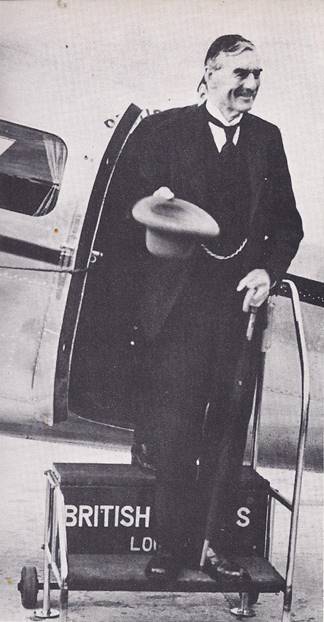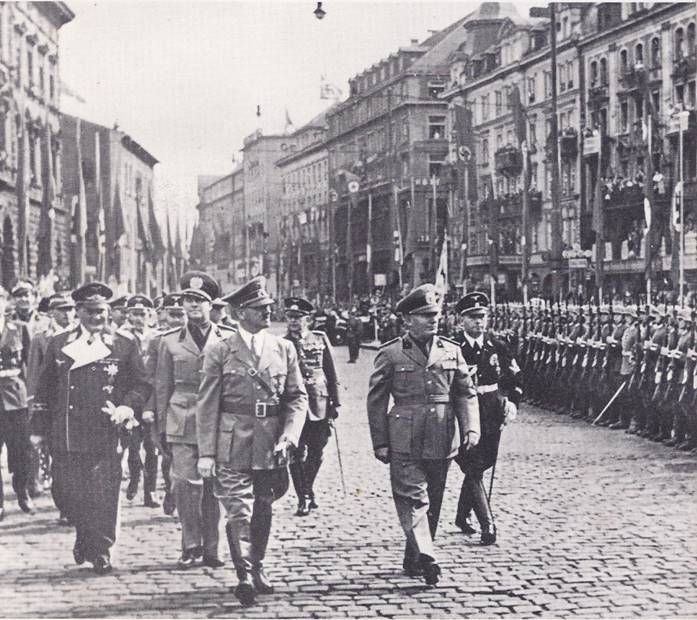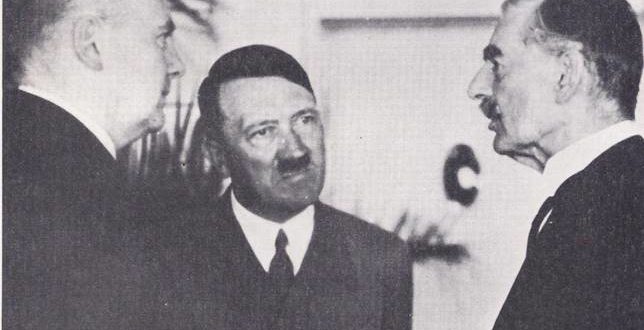Czechoslovakia was a country of many peoples. The largest groups were the Czechs and the Slovaks, but in the region called Sudetenland lived 3,000‚000 Germans. Although Sudetenland had never belonged to Germany — it had once been under the rule of Austria — Hitler was determined to “bring the Sudeten Germans home.” The Nazis had been active in Sudetenland for some time and after Hitler took over Austria they became busier than ever.
Throughout the spring and summer of 1938, the Sudeten Germans made demands on the Czech government. In Germany, there were threatening troop movements. Hitler also began the construction of what became known as the Siegfried Line — fortifications that ran along the Rhine River, stretching from Switzerland to the Netherlands. It seemed as if war would break out at any moment, but Hitler had France, the Soviet Union and Britain to reckon with. France and the Soviet Union had agreed to aid Czechoslovakia if it was invaded and Britain supported France, so at first, Hitler moved cautiously.
Then, in August, danger of war flared up again. The German armed forces called up nearly a million and a half men for maneuvers. At the same time, the Sudeten Germans were carrying on negotiations with the Czech government. The government agreed to give them almost complete control of the Sudetenland, but would Hitler be satisfied? The answer would come on September 12, when Hitler would make a speech to the congress of the Nazi party at Nuremberg.
As that day approached, Britain and France did what they could to strengthen their defenses. The day arrived and Hitler made his speech in a stadium packed with shouting Nazis. He demanded “justice” for the Sudeten Germans. They must have the right to decide for themselves whether or not to join Germany. He promised that they “will receive help from us.” Germany would aid these “tortured and oppressed creatures.”
Immediately, as if by signal, riots broke out in Sudetenland, with the Germans fighting the Czech police. If Hitler was looking for an excuse to invade Czechoslovakia, this was it. The day after Hitler’s speech, the French cabinet met for hours. The French were convinced that Hitler would invade Czechoslovakia. Should they go to Czechoslovakia’s aid? That would mean war and they did not want war. At last they asked Neville Chamberlain, the British prime minister, to try to reach some agreement with Hitler. Chamberlain was openly in favour of “appeasing” Hitler; he felt that if Hitler were given some of the things he wanted, he would stop threatening the peace.
More than willing to talk things over with Hitler, Chamberlain sent him the message:
“In view of the increasingly critical situation I propose to come over at once to see you with a view to trying to find a peaceful solution. I propose to come by air and am ready to start tomorrow.
Please indicate earliest time at which you can see me and suggest place of meeting. I should be grateful for a very early reply.”

Hitler was astonished and delighted. He had expected trouble from France and Britain; now he was sure that they would give in. He invited Chamberlain to Berchtesgaden and at dawn on September 15, Chamberlain set out for Germany. Like many Englishmen, he carried a neatly rolled umbrella. Before the month was over, the tall, lean, owl-faced Chamberlain and his umbrella would be known as a symbol of appeasement throughout the world.
The two men met in Hitler’s study — the same room, with the windows overlooking the mountains, where Hitler had met with Schussnigg. Hitler excitedly told Chamberlain that the Germans in Czechoslovakia must be returned to Germany. He would not back down, even if it meant war. Chamberlain interrupted Hitler’s burst of words to ask, “If the Fuehrer is determined to settle this matter by force without waiting even for a discussion between ourselves, why did he let me come? I have wasted my time.” Hitler became calmer and said that perhaps a peaceful settlement was still possible. Would Britain agree to a union of the Sudeten region with Germany? Chamberlain replied that he would have to consult with his cabinet and the French, but that he personally recognized the right of the Sudeten Germans to join Germany.
Returning to London, Chamberlain discussed the matter with his cabinet and with Premier Daladier of France. On September 19, Britain and France notified the Czechs that, to keep peace in Europe, the areas “mainly inhabited by Sudeten Germans” must be given to Germany. The Czechs called it the “basest betrayal in history.” They further learned that Britain and France would give them no military aid if they stood firm against Germany and they were forced to agree.
On September 21, the Soviet Union offered to aid Czechoslovakia. Its war department was ready to meet with representatives of France and Czechoslovakia to see what could be done. Neither Chamberlain nor Daladier considered the offer. The next day, umbrella in hand, Chamberlain again arrived in Germany. He was amazed when Hitler flew into a rage. Hitler was not interested in settling the Sudeten question in an orderly fashion. Germany must occupy the Sudetenland at once — by October first, at the latest.
THE MUNICH CONFERENCE
To Hitler’s surprise, Britain, France and Czechoslovakia stood firm. Once again it seemed as if war would break out at any moment, but there was still a chance for peace. The United States called for an international conference, appealing directly to Hitler. President Roosevelt joined Chamberlain and Daladier in asking Mussolini to try to avoid war. The result was a conference at Munich on September 29, when Chamberlain, Daladier and Mussolini sat down with Hitler. No Russian was invited and the representatives of Czechoslovakia had to wait in the next room. They had no part in the decision on what was to happen to their country.

At about one o’clock in the morning on September 30, the four leaders came out of the conference room. Chamberlain, as usual, showed no sign of what he was feeling, but Daladier seemed gloomy and defeated. Mussolini was smiling broadly. Hitler, as an eyewitness reported, seemed to be no longer of this earth.” He was “walking on air” — and no wonder. He had been given everything he wanted. His troops were to enter the Sudetenland on October 1. He had made one slight compromise; the German occupation was to take place in five stages.
Chamberlain returned to London, where he was greeted by cheering crowds. He spoke to them from the window of the house at No. 10 Downing Street. He said he had brought back “peace with honour.” Smiling, he added, “I believe it is peace in our time.”
There was no rejoicing in Czechoslovakia. The Czechs felt that they had been betrayed by the man with the umbrella and that their country had simply been handed over to the Nazis. There were people elsewhere, too, who realized the truth. Among them was a member of the British parliament named Winston Churchill. He said, “We have sustained a total, unmitigated defeat. We are in the midst of a disaster. . . . And do not suppose that this is the end. It is only the beginning.”
Events soon proved the accuracy of Churchill’s statement. In October, German troops marched into Sudetenland. By March of 1939, most of Czechoslovakia was under Hitler’s rule. Hungary seized one Czech province and Poland a slice of territory around Teschen. That same month, German troops occupied more than a thousand square miles of Lithuania. The following month, Mussolini gobbled up Albania.
Now even Chamberlain saw that his umbrella of appeasement was no protection against the storm that threatened the world. He had believed Hitler when the Nazi leader said that once the Sudeten question was settled Germany would make no further claims on territory in Europe, but Hitler had taken over Czechoslovakia and his newspapers and radio stations had begun to thunder against Poland. Chamberlain changed his tactics and in April Britain and France signed an agreement to assist Poland if it was attacked.
In giving up Czechoslovakia, Britain and France had lost Czechoslovakia’s fortifications and armed forces. Now they needed more military power and at last they began negotiations with the Soviet Union, but Poland feared the Russians at least as much as it feared the Nazis and refused any real cooperation with them. Then, on August 19, came startling news from Berlin — Germany and the Soviet Union had agreed to sign a non-aggression pact; neither country would fight against the other.
It was hard to believe, for the Nazis had proclaimed themselves the defenders of Europe against Communism, while the Russians had proclaimed themselves the great enemy of the Nazis. Hitler had risen to power partly on the strength of his opposition to Communism and Communists throughout the world had taken action against Nazism and Fascism. Storm troopers had fought Communists in the streets of Germany and Communists had faced Nazis and Fascists across the battle-lines in Spain’s civil war.
Incredible as it seemed, it was true and having made his deal with Russia, Hitler felt free to go on with his conquests. At dawn on September 1, German war planes roared over Poland, dropping bombs on men, women and children. At the same time, German armies rushed across the border. Two days later, Britain and France declared that they were at war with Germany.
World War II, the most deadly and destructive in the history of mankind, had begun.





